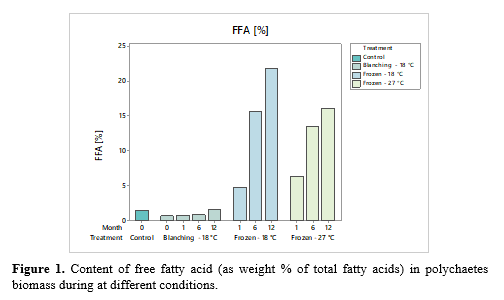STABILISATION OF POLYCHAETE Nereis virens BIOMASS DURING FROZEN STORAGE
Introduction
Cultivation of low trophic organisms, such as polychaetes, has been proposed as one mean for recycling nutrients from sidestreams , and at the same time producing omega-3 rich lipids and marine proteins, that are in high demand both for feed and human applications. Polychaete worms are presently cultivated in both Europe and Asia, but at relatively small scale and mainly sold in the premium feed market (e.g sold as live feed or freeze-dried). Live polychaete worms have particularly showed beneficial effects in shrimp broodstock diets , but the mechanisms responsible for the superior effect of live feed is not known. Marine raw materials are highly perishable, therefore proper handling and preservation methods are needed to maintain the valuable lipids, proteins and other components after harvesting. However, only few studies have investigated the effect of different storage/prosessing conditions on important quality parameters on polychaete biomass .
In order to up-scale and use polychaetes as an alternative aquafeed ingredient – the production and processing should be cost and energy efficient – while still maintaining the quality of the raw material . The goal of the present study was to evaluate the stability of the biomass during different frozen storage conditions , including effect of heat-treatment. Quality was evaluated based on both l ipid and protein composition.
Materials and methods
Cultivated Nereis virens was procured from a commercial producer. Three different storage processes were tested namely 1) industrial frozen worms ( vacuum packed and blast fr ozen (-38 °C) and further stored at – 27 °C, 2) frozen storage in plastic bags at – 18 °C and 3) pre-treated by blanching prior to frozen storage at – 18 °C. Quality was evaluated after 1, 6 and 12 months storage, and compared with control samples , i.e. worms sampled/analyzed directly after snap freezing by liquid nitrogen.
At each sampling point, lipid quality was evaluated based on, oxida tive quality, amount of free fatty acids, fatty acid composition and lipid profile evaluated by Nuclear magnetic resonance spectroscopy. Changes in protein fraction were evaluated based on amount - and composition of amino acid composition, and changes in acid soluble metabolites, such as free amino acids and osmolytes .
Results
Frozen storage, both at – 18 ° C and -27 ° C, led to relative fast changes in lipid composition and quality. For example, the content of free fatty acid significantly increased after 6 months frozen storage compared to control samples. The results show that introducing heat-treatment prior to frozen storage was effective t o prevent activity of endogenous enzymes lea ding to lower lipid hydrolysis during frozen storage (Figure 1).
Lipid oxidation took place during the storage, especially at a storage temperature of –18 °C, both in non-treated and blanched biomass (Figure 2) . On the other hand, v acuum packed worms stored frozen at – 27°C , showed much lower lipid oxidation. Blanching led to reduction of minerals/salt, but also some leakage of lipids and low molecular weight metabolites. The leakage led to higher protein efficiency ratio (PER) of blanched worms – compared to biomass without this pre- treatment. There were only small changes in the profile of low molecular weight metabolites profile during frozen storage.
Discussion and conclusions
In order to use polychaetes as an alternative aquafeed ingredient - there is a need to find economically relevant handling and processing methods of large volumes of biomass, while maintaining acceptable quality. The results obtained in this study – shows that both high endogenous enzymatic activit y and lipid oxidation is a challenge. Therefore e ffective measures to hinder such activity is important, e.g for preserving phospholipids . The results show s that prolonged frozen storage of un-treated biomass should be prevented . P rocessing or fractionation direct after harvesting – could be one solution to maintain valuable lipids and proteins . Blanching is one method for hindering enzymatic activity in biomass with high endogenous activity – and is also beneficial for salt reduction – however, some loss of lipids and free amino acids are anticipated.

